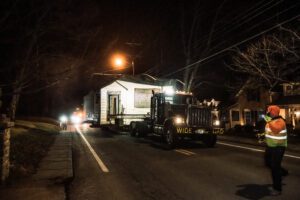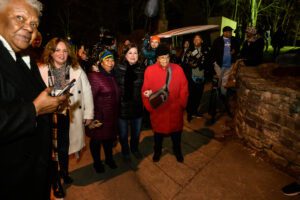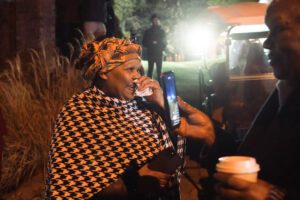 I began my tenure as the Heritage Foundation’s Senior Director of Preservation the night that the Lee-Bucker Rosenwald School made its journey from Spring Hill to Franklin Grove Estate and Gardens at S. Margin Street and Lewisburg Avenue right in the heart of historic Franklin. Despite having done historic preservation work across the country in places like New Orleans, Boston, Los Angeles, and New York, this was the first time I had the opportunity to witness what it takes to move a historic structure. While I’d read about the process when I was in graduate school and stumbled on a surprising amount of historic permits to move buildings in my research, I knew that seeing the move take place in real time would be astounding.
I began my tenure as the Heritage Foundation’s Senior Director of Preservation the night that the Lee-Bucker Rosenwald School made its journey from Spring Hill to Franklin Grove Estate and Gardens at S. Margin Street and Lewisburg Avenue right in the heart of historic Franklin. Despite having done historic preservation work across the country in places like New Orleans, Boston, Los Angeles, and New York, this was the first time I had the opportunity to witness what it takes to move a historic structure. While I’d read about the process when I was in graduate school and stumbled on a surprising amount of historic permits to move buildings in my research, I knew that seeing the move take place in real time would be astounding.
My interest in working at the Heritage Foundation of Williamson County, TN was initially piqued after taking a look at the organization’s preservation projects and seeing the Lee-Buckner Rosenwald School listed. Of the 5,000 known Rosenwald School buildings, less than 500 are estimated to remain today.
As a preservationist, one rarely gets the opportunity to contribute to the rehabilitation, preservation, and interpretation of a Rosenwald School, so I jumped at the chance. When I suggested February 1st as my start date, I had absolutely no idea that would be the night Lee-Buckner would move. When I met with Bari to start my first night, we quickly joined the Lee-Buckner cavalcade to Franklin Grove. It was amazing to see the construction
crew’s careful coordination in guiding Lee-Buckner down Williamson County’s roads. Once we arrived at Franklin Grove, the feeling of excitement was palpable.

Historic preservation advocacy is often tinged with a feeling of impending doom; one is always on the lookout for the next demolition threat. The sense of community and optimism I felt on my first night with the Heritage Foundation was markedly different.
The difference between the Heritage Foundation and many of the other historic preservation projects I’ve been a part of is that the Heritage Foundation is committed to making the community the cornerstone of its preservation practice. The Heritage Foundation‘s initiative to preserve Lee-Buckner Rosenwald School is the perfect example of this. Lee-Buckner’s local alumni, doing justice by their stories, and making sure that their experiences will be shared with generations to come is at the center of this project.

Yes, the Lee-Buckner Rosenwald School’s iconic battery of nine-over-nine wood windows alone are a character defining architectural feature worthy of preservation, but without telling the story of the Rosenwald School program and the experiences of the alumni, we would never truly understand how essential those windows are to the early 20th-century educational philosophy and how they helped pave the way for equal access to education for African Americans.
Seeing everyone from Heritage Foundation staff and board members, to Lee-Buckner alumni and their families, as well as press and other community members gather to celebrate the significance of Rosenwald Schools in United States history and the preservation of Lee-Buckner at Franklin Grove was such a wonderful experience. It is exactly the kind of historic preservation work that I have always wanted to do. The Heritage Foundation of Williamson County, TN is at the forefront of people first preservation and I am honored to be a small part of it.